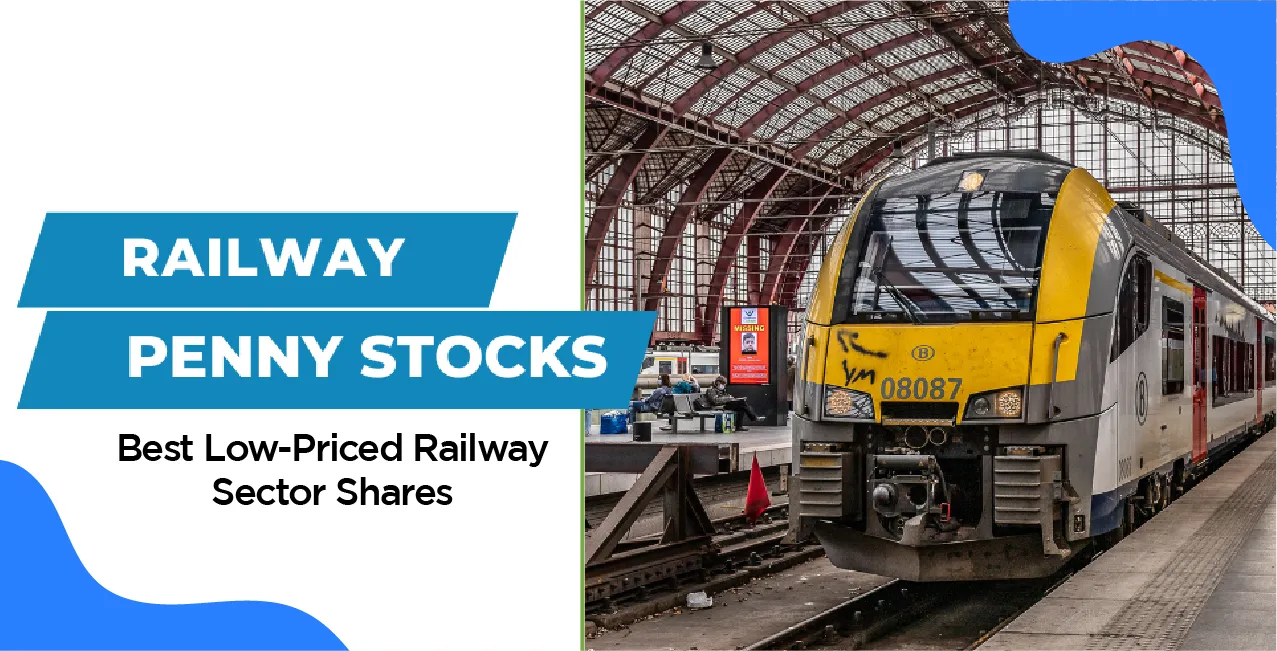
Author
LoansJagat Team
Read Time
18 Min
05 May 2025
Railway Penny Stocks – Best Low-Priced Railway Sector Shares
Railway penny stocks are shares of small railway-related companies that trade at low prices, often below ₹100. These stocks can be attractive to investors seeking high returns, but they also carry higher risk due to factors like limited liquidity and price volatility.
For instance, an investor named Ramesh once invested in a low-priced railway stock that doubled in value over a few months. While such outcomes are possible, not all penny stocks perform this well; some may even lose value quickly.
Below are key characteristics of railway penny stocks:
Characteristic | Typical Range / Nature |
Price | Below ₹100 |
Market Capitalisation | Usually less than ₹500 crore |
Volatility | Prone to high volatility |
Liquidity | Low trading volumes (less buyer/seller activity) |
Return Potential | Potential for high returns |
What is Railway & Why invest in Railway Stocks?
Ananya, a 28-year-old professional from Pune, had already built a small portfolio in IT and banking stocks. After attending a finance workshop, she realised her portfolio was too concentrated. That’s when she decided to explore railway stocks — an underrated but powerful sector.
Read More – EV Penny Stocks List for 2025
Railway stocks refer to shares of companies that operate within the railway sector. These companies may be involved in:
- Infrastructure: Constructing and maintaining railway tracks, bridges, tunnels, and stations.
- Logistics: Offering freight and passenger transportation services across regional and national routes.
- Manufacturing: Producing essential railway equipment, including locomotives, wagons, and coaches.
Investing in railway stocks means putting your money into companies that form the backbone of a country's transportation network.
Why Invest in Railway Stocks?
Why Ananya Chose to Invest in Railway Stocks?
1. Government Support and Infrastructure Development
While researching, Ananya discovered that India’s government was heavily investing in railway modernisation. Massive projects like the Mumbai-Ahmedabad bullet train, electrification drives, and station redevelopment programs were underway.
She understood: Government spending would directly benefit railway companies. It was like catching a train just as it was picking up speed!
2. Economic Growth Linkage
Ananya read that railways are the arteries of a growing economy. Every time industries produce goods or cities expand, railways are vital to moving materials and people.
In her words:
“If the economy grows, railways grow automatically.”
3. Long-Term Growth Potential
Urbanisation trends suggested that India’s population would increasingly demand better transport solutions. Ananya liked that railways aren't a short-term play; they are a bet on India’s future for the next 20–30 years.
4. Portfolio Diversification
Most of Ananya’s money was sitting in the tech and finance sectors. Investing in railway stocks like IRCON, RVNL, or Texmaco Rail gave her exposure to infrastructure and capital goods, lowering her overall portfolio risk.
Her portfolio now looked more like a balanced train, not just a single carriage!
5. Technological Advancements
She was fascinated to see how Indian Railways were adopting AI-driven route management, energy-efficient engines, and smart ticketing systems.
Ananya believed companies innovating faster would gain a competitive edge — a key factor for any smart investor.
6. Increasing Passenger and Freight Demand
Lastly, India’s growing middle class and booming industries would mean more passengers and more cargo. Freight corridors, high-speed trains, and increased connectivity would all drive revenue for railway companies.
Reasons To Invest In Railway Penny Stocks
1. Record-Breaking Government Investment
The Union Budget 2024–25 allocated a historic ₹2.6 trillion to Indian Railways, the largest ever. This funding is focused on rail route electrification, station redevelopment, and new technology integration.
Example:
Ramesh Iyer, a 42-year-old retail investor from Pune, had invested in RVNL (Rail Vikas Nigam Ltd.) in early 2023 when the stock was trading at ₹70. Following the 2024 budget announcement, the stock climbed to ₹180 within a year, yielding over 150% returns. He attributes this to the company's direct involvement in government infrastructure projects.
2. Rapid Modernisation Initiatives
Key projects such as the Vande Bharat Express rollout, 100% electrification, and the PM Gati Shakti cargo initiative are designed to boost speed, efficiency, and sustainability.
Example:
Sonal Mehta, a portfolio manager in Mumbai, added Titagarh Rail Systems to her fund in mid-2023. The company had just secured a coach manufacturing contract under the Vande Bharat project. In just six months, the stock rose by 60%, driven by increasing investor confidence in the company's growth outlook.
3. Consistent Growth in Passenger and Freight Demand
Indian Railways transports over 23 million passengers and more than 3 million tonnes of freight every day. Urbanisation and e-commerce are further driving freight volumes.
Example:
Vikram Sethi, a logistics entrepreneur, diversified his portfolio by investing in CONCOR (Container Corporation of India). In FY24, the company reported a 16% increase in revenue, supported by rising container traffic. Vikram’s stake grew in value by over 25% in one year, providing a stable and scalable return.
4. Privatisation and Policy Support
Government reforms now allow for greater private participation in train operations and rail-related manufacturing, creating more room for public-listed companies to grow.
Example:
Anjali Rao, an early-stage investor in infrastructure stocks, picked IRCTC (Indian Railway Catering and Tourism Corporation) during its IPO in 2019. Despite market fluctuations, the stock delivered multibagger returns, especially after the government allowed more flexibility in online ticketing and tourism services, where IRCTC holds a monopoly.
5. Long-Term Structural Growth
Railways are the backbone of India’s logistics and mobility ecosystem. With policies supporting high-speed corridors, semi-private trains, and cargo hubs, the sector is positioned for decades of growth.
Example:
Devansh Patel, a financial advisor, refers to railway stocks as “India’s future-proof sector.” He advises clients to consider them for long-term wealth creation, especially those companies with consistent government contracts and strong fundamentals.
Key Factors Affecting Railway Penny Stocks
Ravi, a 28-year-old investor based in Bangalore, after studying lithium stocks, turned his attention toward railway penny stocks. He noticed these stocks offered exciting opportunities but also carried significant risks. His research revealed that several critical factors influenced the performance of railway penny stocks in India. Here’s what he found:
Factor | Impact |
Government Infrastructure Push | Policy support and budget allocations can cause sudden rallies in railway penny stocks, but reliance on public spending also creates volatility if funding slows. |
Project Execution Capabilities | Smaller companies often face delays and cost overruns, leading to earnings instability and erratic movements in railway penny stocks. |
Capital Constraints | Many railway penny stocks belong to companies with limited access to cheap capital, making them vulnerable during high-interest rate periods or financial slowdowns. |
Dependence on Big Contracts | Winning or losing major government or private contracts can significantly impact revenues, causing sharp price movements in railway penny stocks. |
Volatility in Freight and Passenger Demand | Fluctuations in demand for rail freight and passenger travel directly affect earnings potential, leading to inconsistent returns from railway penny stocks |
Competition from Larger Players | Big players with better technology and financial resources can outbid smaller firms, putting downward pressure on the stock performance of railway penny stocks. |
Labour and Regulatory Issues | Strikes, regulatory hurdles, and compliance costs are disproportionately harder on small firms, increasing operational risk for investors in railway penny stocks. |
Technological Adaptation | Companies that lag in adopting modern technologies like automated signalling, smart ticketing, or green locomotives may lose relevance, hurting the value of railway penny stocks. |
Asset Heavy Models | Many firms classified under railway penny stocks have asset-heavy models, meaning high depreciation and maintenance costs, which can drag down profitability over time. |
By understanding these factors, Ravi learned that railway penny stocks could offer impressive gains if carefully selected, but only for those ready to handle the higher risk and volatility that comes with investing in this emerging segment.
Best Railway Penny Stocks
Note: This data has been taken from the official website of Google Finance.
Stock Name | Market Cap | P/E ratio | Dividend Yield (%) | 1 year return (%) |
Oswal Overseas Ltd | 157.78M INR | – | – | 137.55 |
Binani Industries Ltd | 560.20M INR | 10.26 | – | 8.57 |
Ashima Ltd | 5.75B INR | 6.54 | – | 31.29 |
Country Condo's Ltd | 841.01M INR | 142.18 | – | 61.79 |
Pentokey Organy (India) Ltd | 340.29M INR | 143.88 | – | 0.00 |
Manaksia Steels Ltd | 4.81B INR | 50.03 | – | 25.27 |
Hanman Fit Ltd | 64.05M INR | 20.26 | – | 7.58 |
3C IT Solutions & Telecoms (India) Ltd | 198.66M INR | – | – | 26.93 |
Kahan Packaging Ltd | 210.12M INR | 16.39 | – | -9.12 |
Libord Finance Ltd | 351.99M INR | – | – | 143.04 |
Factors To Consider Before Investing In Railway Penny Stocks
Priya, a 30-year-old financial analyst from Hyderabad, was excited to expand her investment portfolio beyond the usual blue-chip stocks. She had heard about the potential of railway penny stocks, low-priced stocks of companies involved in the railway sector. However, being cautious by nature, Priya decided to research carefully before diving in. Here’s what she focused on:
1. Financial Health of the Company
Priya knew that many railway penny stocks belonged to companies with weak balance sheets. She made it a point to check:
- Debt levels
- Cash flows
- Profit margins
If a company was heavily burdened with debt or struggling to generate consistent profits, she crossed it off her list.
2. Order Book Strength
She realised that railway penny stocks often move based on government or private sector contracts. So, she carefully examined:
- The current size of their order books
- Types of projects (infrastructure, signalling, coach manufacturing)
- Duration and execution capability
A company with a healthy and diversified order book gave Priya more confidence.
3. Management Quality
Priya believed that leadership matters even more in small companies. She looked into:
- The track record of the promoters
- Past project executions
- Any history of fraud or regulatory issues
For railway penny stocks, she knew, good management can make the difference between survival and failure.
4. Market Position and Competitive Edge
Not all companies could compete with giants like L&T or IRCON.
Priya asked:
- Does the company have a niche (like coach interiors, bridge building, or electrification)?
- Are they preferred partners for certain government projects?
Companies with specialised skills had better chances of long-term survival among railway penny stocks.
5. Government Policies and Support
Since the railway sector is heavily influenced by government policies, Priya kept a close watch on:
- Budget allocations to railways
- New initiatives like the privatisation of stations or high-speed rail corridors
- Electrification targets and green mobility plans
She knew that favourable policy changes could cause a surge in railway penny stocks, but sudden policy reversals could hurt them badly too.
6. Liquidity and Trading Volumes
Priya also checked whether these stocks had enough daily trading volume. Some railway penny stocks looked attractive on paper but had very low liquidity, meaning it would be hard to sell quickly if needed.
7. Risk Appetite and Time Horizon
Finally, Priya asked herself the tough questions:
- Was she willing to tolerate volatility and sudden price swings?
- Could she invest for 3–5 years without panicking?
Since railway penny stocks are highly volatile, Priya decided to only allocate a small portion of her portfolio to them, money she could afford to risk without losing sleep.
Challenges And Risks In Railway Penny Stocks
Rohit, a 32-year-old investment analyst from Delhi, had been tracking railway penny stocks for several months. As he dug deeper, Rohit realised that although the sector offered exciting growth opportunities, railway penny stocks came with their own set of challenges and risks. These factors could significantly impact stock performance and require careful consideration before investing.
Risk | Impact |
Dependence on government projects | Heavy reliance on public sector contracts makes railway penny stocks vulnerable to political and budgetary changes. Any delay or cancellation can hurt revenue streams. |
Weak financial strength | Many companies behind railway penny stocks have limited cash reserves and high debt, making them more exposed during economic slowdowns or funding crunches. |
Execution delays and cost overruns | Small players often struggle with timely project completion, leading to penalties, cost escalation, and earnings disappointments, which negatively affect railway penny stocks. |
Intense competition from larger players | Big infrastructure companies with better resources can easily outbid smaller firms, reducing the market share and growth potential for railway penny stocks. |
Regulatory and compliance risks | Changes in safety standards, environmental regulations, or labour laws can increase operational costs and compliance burden for smaller railway firms. |
Vulnerability to economic cycles | Railway penny stocks are highly cyclical. Economic downturns can reduce infrastructure spending, hurting new project inflows and slowing revenue growth. |
Low liquidity and high volatility | Many railway penny stocks trade with low volumes, making them prone to sharp price swings and difficult to exit during market corrections. |
Technology lag | Companies slow to adopt new technologies like digital signalling, green energy solutions, or smart ticketing could lose their competitive advantage, weighing down their stock performance. |
Future Of Railway Penny Stocks
Karan, a 29-year-old entrepreneur from Ahmedabad, had always been fascinated by the infrastructure and transportation sectors. Recently, he started studying railway penny stocks, intrigued by how these small companies could one day ride the wave of India’s railway modernisation.
After weeks of deep research, Karan became convinced: while railway penny stocks carried risks, their future looked increasingly promising if approached wisely.
Why Karan Believes in the Future of Railway Penny Stocks?
1. Massive Government Push for Modernisation
Karan noticed that the Indian government was investing heavily in:
- High-speed rail projects like the Mumbai-Ahmedabad bullet train
- Station redevelopment across major cities
- Electrification of railway tracks to promote green mobility
He realised that companies supporting these initiatives — even smaller ones — could see substantial order inflows, giving railway penny stocks a strong growth runway.
2. Focus on Privatisation and Public-Private Partnerships
Karan observed the Indian Railways' shift toward involving private players in:
- Train operations
- Cargo handling
- Station management
This trend could open doors for smaller, agile companies.
Railway penny stocks involved in these projects might become tomorrow’s mid-cap or even large-cap stars if they grab early opportunities.
3. Rising Demand for Freight Corridors
India's Dedicated Freight Corridor (DFC) project excited Karan.
The massive movement of goods via rail would require:
- New tracks
- Signal systems
- Maintenance services
- Freight wagons
Karan knew that railway penny stocks operating in niche areas like rail logistics, freight wagon manufacturing, or track laying could benefit immensely over the next decade.
4. Technological Upgrades Driving Growth
Modernisation isn’t just about concrete and steel — it’s about smart railways.
Indian Railways is adopting:
- AI-driven route management
- Smart ticketing systems
- Energy-efficient locomotives
Companies that adapt to these tech demands — even small ones — could gain significant relevance.
Karan saw this as a tech-revolution opportunity hidden inside traditional railway businesses, boosting prospects for select railway penny stocks.
5. Urbanisation and Metro Expansion
Cities like Mumbai, Delhi, Bengaluru, and Ahmedabad were expanding their metro networks and suburban rail systems.
Karan realised that companies working on:
- Metro rail construction
- Station upgrades
- Ancillary services
Who Should Invest in Railway Penny Stocks?
Neha, a 27-year-old marketing professional from Pune, had been investing in mutual funds and a few blue-chip stocks for three years.
Recently, she started hearing about the potential of railway penny stocks — low-cost stocks of companies involved in India’s booming railway infrastructure story.
Neha was excited but cautious.
Before jumping in, she wanted to understand: "Are railway penny stocks meant for someone like me?"
Through her research and conversations with financial advisors, she figured out who should consider investing in railway penny
stocks — and who should avoid them.
What Neha Learned
1. Investors with High Risk Tolerance
Neha realised that railway penny stocks can be extremely volatile.
Prices could rise sharply but also fall suddenly based on news like project delays, earnings misses, or government policy changes.
Only those comfortable with wild ups and downs — and who understand the risk of partial or total loss — should invest.
2. Long-Term Investors
Neha discovered that railway penny stocks often take years to show their true potential.
These companies usually:
- Depend on big projects that have long gestation periods
- Need time to scale up and improve their financials
- May suffer short-term challenges before turning around
So, patient investors who can hold their investments for 3–5 years or more without panicking are better suited.
3. Investors Looking for Small Allocation Bets
Neha realised she shouldn't bet a large chunk of her portfolio on railway penny stocks.
Instead, such investments should make up a small, high-risk-high-reward slice — maybe 5%–10% of her overall investments.
This way, even if a few picks failed, her core portfolio (blue-chips, mutual funds) would remain safe.
4. Those Willing to Research Deeply
Neha saw that not all railway penny stocks were created equal.
Some were genuine emerging businesses with great prospects, while others were poorly run companies looking to cash in on investor hype.
Success required:
- Reading company financials
- Tracking order wins and project updates
- Understanding management quality
- Watching sector policies closely
Investors ready to put in serious research effort — or consult experts — had a better chance of finding winners.
5. People Who Can Handle Low Liquidity
Lastly, Neha found that many railway penny stocks had low trading volumes.
This meant that if she needed to sell urgently, she might struggle to find buyers without slashing her selling price.
So, investors who don’t need quick liquidity and can hold patiently without being forced to sell are better suited for this space.
How to Invest In Railway Penny Stocks?
Choose a Broker:
Select a trusted brokerage platform like Zerodha, Groww, Upstox, or Angel One.
Account Opening:
Visit the broker’s website or app to open your Demat and trading account. The steps usually involve:
- Providing personal details (name, PAN, Aadhaar, bank account information).
- Completing KYC (Know Your Customer) verification, which may include Aadhaar-based e-KYC, selfie/video verification.
- E-signing the application form using an OTP sent to your Aadhaar-linked mobile number.
Link Bank Account:
Connect your savings bank account to your trading account for easy deposits and withdrawals.
Research Railway Penny Stocks
Before investing, it’s crucial to thoroughly research and identify promising railway penny stocks. Some small-cap companies associated with railway infrastructure, services, and manufacturing include:
- Texmaco Rail & Engineering Ltd: Engaged in the production of rolling stock, infrastructure construction, and signalling systems.
- Rites Ltd: Provides engineering consultancy services in transport infrastructure, including railways.
- IRCON International Ltd: Specialises in large-scale railway construction projects.
- Titagarh Rail Systems Ltd: Manufactures freight wagons, passenger coaches, and metro coaches.
Also Read – How to Select Stocks for Intraday
For instance, Texmaco Rail has been actively participating in the government's railway expansion and modernisation projects, making it a potential candidate in the railway penny stocks space.
Place Your Order
Log In:
Access your trading account through your broker’s app or web portal.
Search Stocks:
Use the search bar to locate the railway penny stock you are interested in, such as Texmaco Rail or Titagarh Rail Systems.
Buy Order:
Enter the quantity of shares you wish to buy and specify the buying price (or place a market order if you want to buy immediately).
Confirm:
Double-check all the details and confirm your order to complete your investment.
Monitor Your Investment
Track Performance:
Regularly track how your railway penny stocks are performing using your broker’s platform.
Stay Informed:
Keep yourself updated with news about the Indian Railways, infrastructure development plans, project announcements, and government budget allocations.
Additionally, monitor sector-specific updates like high-speed rail corridors, metro expansions, and technological advancements in railway operations, as these factors can significantly influence the valuation of railway penny stocks.
Final Thought: Should You Invest in Railway Penny Stocks?
Railway penny stocks offer a unique chance to tap into India's growing infrastructure story, but they come with high risk and volatility. They are best suited for investors with a strong risk appetite, a long-term outlook, and the patience to ride out market ups and downs. If you are willing to allocate only a small part of your portfolio, do thorough research, and stay updated on railway sector developments, investing in railway penny stocks could be a rewarding opportunity. However, cautious and well-informed investing is key.
Other Stocks List | ||
About the Author

LoansJagat Team
‘Simplify Finance for Everyone.’ This is the common goal of our team, as we try to explain any topic with relatable examples. From personal to business finance, managing EMIs to becoming debt-free, we do extensive research on each and every parameter, so you don’t have to. Scroll up and have a look at what 15+ years of experience in the BFSI sector looks like.

Quick Apply Loan
Subscribe Now
Related Blog Post


